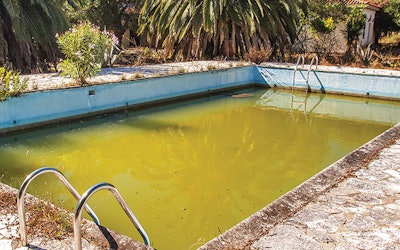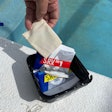
Although not a ubiquitous problem, in some areas abandoned pools remain a hazard that reflects poorly on the industry. The pool and spa industry refers to an abandoned pool as being “devoid of water,” as having “no liquid assets” or as “left high and dry.” Even if filters and pumps are operational, a pool is considered abandoned when the water level falls too low for proper sanitation.
Why are pools abandoned? Pumps fail and funds aren’t available for repair; pool chemicals become too expensive for strained budgets; caretakers become disabled; homes are foreclosed upon; natural disasters force evacuation. Some of these circumstances may affect one pool in a community while others affect entire regions.
In 2013, APSP (now PHTA) reported there were nearly 9 million commercial and residential pools in the U.S — both operational and abandoned. Economic circumstances for families and municipalities can determine the fate of any one of these pools. Downturns in any budget can put an end to the use (and maintenance) of a pool.
As an example, in 2010, during the most recent recession, news outlets reported that all but one of 41 community pools in one city on the Eastern Seaboard had been closed due to a cash-strapped government budget.
RELATED: Historic Restorations
There are myriad reasons why any pool might be abandoned. This Tech Notes will address the effects of abandonment — when pools are left to hold only untreated, unfiltered, uncirculated (stagnant) water. Among other hazards inherent in such pools, this environment serves as an ideal breeding and feeding ground for mosquitoes, which are notorious for carrying and transmitting the West Nile virus and Saint Louis encephalitis virus (SLEV).
FOOD SOURCE
A working circulating pump is necessary for proper pool filtration and sanitation, as well as for the control of West Nile virus. Mosquitoes lay eggs in standing water. This can happen nearly anywhere; however, mosquito larvae need to consume organic matter and microorganisms in order to mature to adulthood, and these items are only present in abandoned, unfiltered, untreated pools.
A well-maintained pool eliminates food sources for mosquito larvae, and therefore reduces the proliferation of mosquitoes, West Nile virus, and SLEV.
It is recommended that the following precautions be taken by homeowners and commercial pool operators when encountering an abandoned pool:
• Maintain the manufacturer-recommended levels of sanitizer in the pool. (Not only does this control microorganisms, which serve as food for mosquito larvae, chlorine has been reported to kill mosquito eggs.)
• Ensure the filters are working properly. Regularly skim, vacuum, scrub, brush and backwash to eliminate any organic matter.
• Conduct testing to ensure proper water balance.
• Drain, clean and cover (or backfill) abandoned pools to prevent refilling with rainwater that becomes stagnant, creating mosquito-breeding surfaces.
• Empty other water-holding structures like bird baths, flower pots and pool covers to discourage the proliferation of mosquito populations on the property.
PRECAUTIONS
When conducting abandoned-pool cleanup, the wearing of mosquito-resistant clothing and mosquito repellent containing DEET is recommended. It is also best to perform cleanup operations during daylight hours, since mosquitoes tend to bite after dark.
RELATED: Premier Pools Completes Abandoned Pool for Newlywed Couple
Most people who contract West Nile virus will develop West Nile fever, which is relatively mild and unlikely to require medical attention. Symptoms include a low-grade fever, body aches, headache and fatigue. A lesser number of infected people (about 1 in 100) will develop West Nile encephalitis or West Nile meningitis, which can result in high fever, confusion, convulsions, severe headache, partial paralysis, inflammation of the brain, swelling of the spinal cord and even death.
The symptoms and spectrum severity of SLEV are similar to those of West Nile virus.







































